Star Trek: The Motion Picture – Inside the Art and Visual Effects
Written by Jeff Bond and Gene Kozicki
Published by Titan Books on September 1, 2020
Available as a 192-page hardcover coffee table book
There Is No Comparison
December 7, 1979. A release date that will live in infamy.
That firm, studio-mandated deadline put extra pressure on a production that began as a revamped TV series and ballooned into what was, at the time, the most expensive movie ever made. And when the original visual effects team got fired ten months before that date, with almost no usable footage shot, well, Star Trek: The Motion Picture needed a miracle worker to help it reach theaters in time.
That’s the received wisdom as it has filtered through the Star Trek community over the years, with legendary effects wizards Douglas Trumbull and John Dykstra justly hailed as the primary talents who saved the film. And while in broad strokes all that remains true, a new book by Jeff Bond and Gene Kozicki helps paint a more detailed portrait of the contributions Robert Abel & Associates made to the look of what is (arguably) still the most cinematic Star Trek film – contributions that continue to resonate within the franchise to this day.
Star Trek: The Motion Picture – Inside the Art & Visual Effects tells the story of the film’s production through the lens of the effects departments. Utilizing new and archival interviews, along with hundreds of photographs, the book takes us through the film’s on-again-off-again development, sometimes frustrating execution, and ultimately even the well-received 2001 Director’s Edition. It’s a fascinating look at the numerous creative artists who helped relaunch the Enterprise.
Primary among those artists were, of course, Trumbull and Dykstra, along with the teams of artists they each brought to the project. And while the book spends plenty of time covering their work, it also zooms in on lesser-known – but just as vital – contributors such as Lee Cole, Andy Probert, and even Production Designer Harold Michelson. Maybe the greatest unsung hero brought to light here, though, is Richard Taylor, a key visual effects art director with Robert Abel & Associates (later known as ASTRA).
Abel’s team first became attached to Paramount’s Star Trek revival on the strength of their television commercial work. A famous Levi’s spot, in particular, offered the kind of hallucinogenic brilliance that impressed the producers.
After determining that the models and sets that had already been constructed for the aborted “Phase II” TV series were not good enough to pass muster on a motion picture screen, ASTRA’s Richard Taylor ultimately oversaw the redesign work on the new USS Enterprise and sets as well as general Starfleet design elements. The rounded corners and art nouveau touches Taylor instituted are only some of the places his work changed the look of Star Trek forever. As the authors note in their foreword, one of the book’s goals was to “rehabilitate the reputation” of ASTRA, and their look at Taylor’s influence alone does a great deal toward accomplishing that.
Of course, that’s only a small part of the book’s focus, but also a good example of the detail that makes it such a joy to read. Bond and Kozicki bring us deep into the weeds of the production process, isolating many of the myriad elements that were discussed, designed, debated, redesigned, and finally executed as the effects teams worked 24 hour days trying to meet that implacable deadline. Chapters covering the redesigned Enterprise and the reconfiguration of the Klingons are particularly interesting, as are the many looks at the evolution of V’ger. I also really enjoyed learning more about the scrapped Memory Wall sequence and how it transformed into the memorable Spock Walk.
As befits an oversize coffee table book, though, the excellent text is only part of the story, and Star Trek—The Motion Picture – Inside the Art & Visual Effects is packed with wonderful photos. Will true TMP aficionados find anything new here, photos they haven’t seen? I don’t know, but it sure felt new and revelatory to me.
Students of visual effects will relish the insights and contributions found here from some of the field’s giants – not just Trumbull and Dykstra, but Syd Mead, Ralph McQuarrie, and Robert McCall. Fans of film history in general and Star Trek: The Motion Picture in particular will be delighted at the rich trove of material offered, going behind the scenes in a way that not even a documentary could. Those who’ve read and enjoyed Preston Neal Jones’ terrific Return to Tomorrow will find only a little bit of overlap while also being gifted the photos that were absent from that earlier book.
But the real beauty of Star Trek: The Motion Picture – Inside the Art & Visual Effects is that it will also reward the more general Star Trek fan. Bond and Kozicki give us a much-needed look into the heart of Star Trek: The Motion Picture, at the real human adventure that brought the movie to life. And even if it’s not your favorite Trek film, it’s the one that made everything that followed possible. For that alone, the movie – and this book – should be treasured.
Available Now
Star Trek: The Motion Picture – Inside the Art and Visual Effects by Jeff Bond and Gene Kozicki was published by Titan Books on September 1, 2020. The 192-page hardcover coffee table book retails for $50.00, but you can order it at Amazon for $36.86.
Keep up with all the Star Trek merchandise news and reviews at TrekMovie.com.

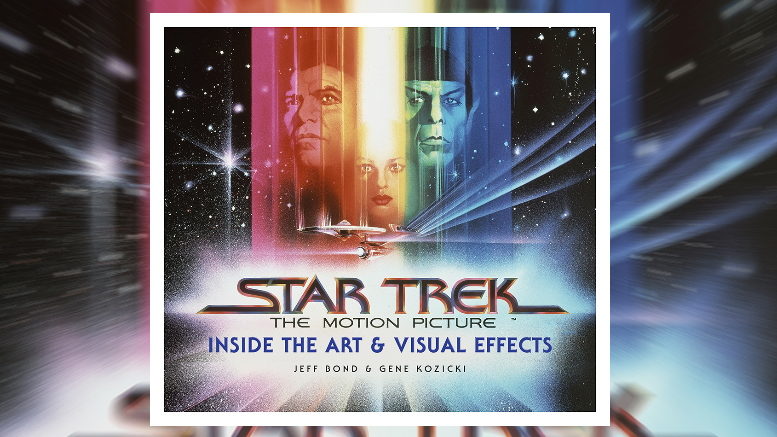



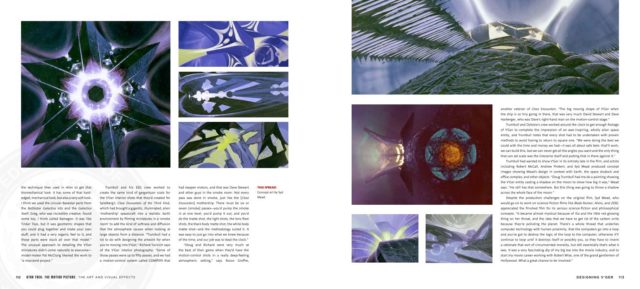

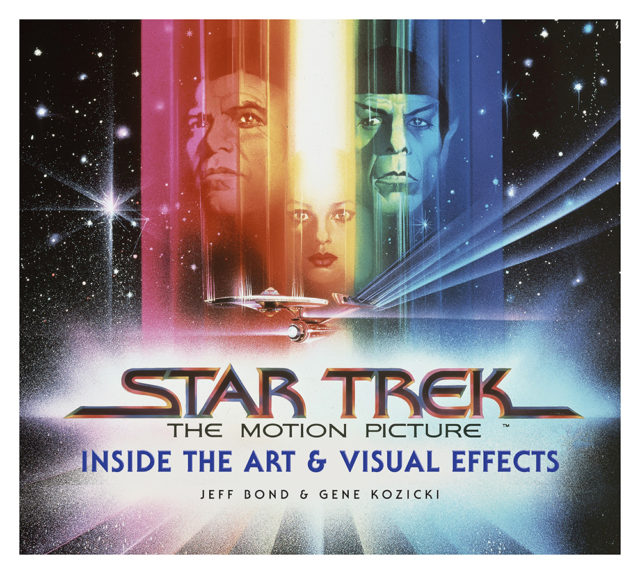
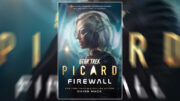

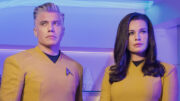
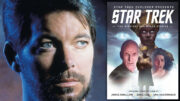
this looks great. so many trek films have tumultuous journeys to the big screen… but the motion picture has the most crazy story… the movie itself as we all know is slow but gorgeous and theatrical and i think after all these years a pleasure to watch. just too serious.
Richard Taylor is the unsung hero? “Kirk to spin control, what’s going on down there?”
I remember going to see ST:TMP on opening night, December 1979. As my friends and I left the theatre we all looked each other and said WTF was that?!
Over the many years since, having watched it countless times (including the Director’s Cut), I’ve come to appreciate what they TRIED to do, in spite of the glacial slow pace of it.
that was my reaction to that Levi’s commercial
Yes, endless reaction shots of characters looking at a screen does not an epic make! And V’ger itself was a tacky looking set with silly sound effects. An ending as disappointing as ‘Apocalypse Now’ would be.
I blame the studio for allowing that version to stand for years until wise was allowed to put together the director’s edition.
the first hour of the film is fine but they should have got kirk, spock off the bridge minutes after they went inside v’ger, exploring the ship.
I got the book a few weeks ago and it is a great present for fans of TMP. The writers manage to unearth some nuggets of information that I was not aware of and it’s interesting to read about the professional connections between so many of the people who worked on the movie. I’m especially happy that Harold Michelson’s work was finally recognized as I always felt he played a pretty big part in the look of the movie. My only, very minor quibble, is that certain people who also had a profound impact on the movie are barely mentioned. Brick Price Movie Miniatures was tasked with creating many of the film’s props but get maybe one sentence in the entire book. Sam Nicholson and Brian Longbotham, who designed the lighting effects for the engine room and the V’Ger temple, likewise get very little coverage. Overall though, it’s a fun read with some great photos and I’m happy to be able to add it to my library.
It’s a matter of whose perspective you’re taking when you get into who is omitted. What’s funny is that BP was one of the few saying decent things about Abel at the time, even in print for STARLOG. He dismissed the highly-repeated line that Abel had shot almost no film in a year, saying he saw minutes on the first dailies he attended. However, he did call Abel/Taylor out for the way they jumped all over Don Loos for the discarded P2 Enterprise, so I think he was just being honest.
HOWEVER, Abel wouldn’t show the studio any of this film, so it amounted to being no film (and except for about four frames of the wormhole explosion — which is so bad that if you freeze frame on it, you can see the blast is taking place on something that looks like a trampoline, inverted — in the theatrical, none of their work is in the film, unless you count the rest of the wormhole, which wasn’t finished under his direction, but under Trumbull’s through Bob Swarthe and co.)
Not sure what you mean about Michaelson not being recognized, he was interviewed in FANTASTIC FILMS and elsewhere at the time of release, and gets plenty of pages in RETURN TO TOMORROW as well, plus he got an Oscar nom.
I knew Harold Michelson in the 90s as my boyfriend at the time was a set designer and was good friends with Harold and his wife Lillian. Imagine my joy as a hardcore Trekkie being able to talk with him for hours about his time on TMP. So many great stories. So glad he’s getting credit for his contribution. <3
TMP is THE ultimate Trek movie, and I can’t get enough of it. There’s no arguing that it’s the most cinematic TOS movie, and to me it’s definitely far and away the most beautiful Trek movie with the best score. Yeah, I get that it wasn’t what fans wanted or expected at the time, or even to this day, but to me it hits all the right notes and feels the realest. I think the producers hit a home run, and I’m so grateful they made their deadline so we could have the 40 years of Star Trek that has followed. This book looks awesome and I’ll be asking Santa for it this Christmas!
It’s my favorite of all the movies, and only a couple of the others even come close.
Agreed, this film is like a meditation for me. It is perhaps the only Trek movie that truly takes me to the unknown and makes me live there for about 2 hours.
I feel it is the most “futuristic” of all the Trek films.
What? You didn’t think that Nick Meyer’s kitchens and fire extinguishers were futuristic? Or JJ’s steampipe-filled engine room?
I call it the ‘Bad Karma’ movie; none of the characters (except Kirk) wants to be on the ship. The old chemistry between the trio is completely absent. Nimoy sounds like he has a bad cold, etc. Awful.
lol I mean you’re right for sure, and it does feel sterile and lacking in personal humanity in a lot of ways. But I suppose that’s what makes it feel “real” to me – these are older characters, they’ve been apart, there *shouldn’t* be the same dynamic. This is an emergency and everyone’s scared sh*tless and this ain’t no adventure of the week. So I do understand the why behind those choices, even if they aren’t as emotionally satisfying as if it had just been like it was in TOS.
that is the point.
the characters, especially spock and kirk, are at a crossroads in their lives which adds tension to the film. the duo seem to be driven by forces that may hamper the mission.
something that plays out right up to kirk and spock’s last appearances in the movies.
but they seem at peace by the end after decker’s ascension with v’ger.
Other than McCoy, everyone wanted to be on the ship. None of the bridge crew ever voiced a reservation about returning. Spock aborted his Kolinahr ceremony and actively sought out the ship to rejoin the crew, even if it was for his own personal needs at first. Decker and Ilia never complained about being on the Enterprise.
As to the absence of chemistry between the main three, that was the whole point of Kirk’s and Spock’s character arcs. Kirk and especially Spock were all damaged at the start and had to figure out how to reconnect with one another and those around them. For Kirk, he had to get over his own anxiety about no longer being familiar with his ship and fear of being wrong from rustiness due to not being in space for years. Spock’s character arc takes a massive jump forward in this movie and it directly speaks to how he finally reconciles his human and Vulcan halves. The calmer, more at peace Spock we see in the later movies, TNG and even the 2009 movie would not exist if he didn’t go thru the experiences from TMP.
Bravo, TonyD! You absolutely nailed it :)
Yeah, I believe that the Spock we see in TWOK is absolutely a result of TMP (and there was at least one draft before Meyer came on that reflected this, in a log entry Spock makes before his (then-early in the film) death.
So in a sense, we never do get Spock back later, because there’s never that sense of reconciling everything in his later performances, despite what he says at the end of TVH. I think he comes closest early in TFF, but I think Kirk and Spock are seriously character-assassinated by the TUC writing, and Nimoy seems to push in very weird directions at times.
spock tripping up kirk by not discussing his overture with the klingons and then embarrassing him at the dinner was strange.
I’ve seen speculation that this is Spock’s friendship with Kirk manifesting in a drastic way, like, ‘you will deal with your son’s death and give up your hate, even if I have to force you to do so,’ which would be a pretty big step in the way he dealt with Kirk. Can see how somebody desperate to like the movie would grasp at this, but don’t recall Nimoy or anyone actually saying this is so.
Spock does tell Picard later in ‘unification’ that he knew he messed up back then and was only willing to risk his own life coming to Romulus alone.
TMP gifted the franchise those character arcs even if the film was seen a disappointment.
I agree! It’s my favorite of the Trek Films too! Absolutely immersive and it feels like you are reading a really great sci fi book that gives you that sense of awe and large scale expansiveness of the universe.
Books by insiders get the full treatment; important books by others are totally ignored. This is an excellent book, though. But coverage of all worthy non-fiction Trek books would be appreciated.
The uniforms were the only bad thing about this movie.
I know that this is not a popular opinion, but I rather liked them.
in my opinion they looked much better than the Wrath of Khan uniforms
I’m with Dirty Batman on this one.
Yes, I love these uniforms, they look comfortable and they’re like a more believable upgrade to the TOS uniforms.
Same here, I preferred them to the latter efforts as they just seemed more functional.
I enjoyed reading my copy quite a lot, however, one area that I found the book sadly lacking was the coverage of the design & building of the Stage II Enterprise sets and the transition & upgrading to The Motion Picture. I would have loved to have seen set renderings, layouts & blueprints as well as any construction photos documenting the evolution of the bridge, corridors & engineering room on Stage 9. That stage plan in particular became a mainstay for Star Trek for the next twenty years (in one form or another from TMP to Voyager). The art & stage design are as iconic as the Enterprise starship design in my opinion, and the book totally glossed over that in its entirety.
one of the images on the v’ger mead spread pages (middle of 113) shown above isn’t even artwork, let alone Syd’s … it is a special photo of the Apogee miniature taken by VFX guy Chuck Barbee that accompanied his piece on the film in INTERNATIONAL PHOTOGRAPHER magazine (now called ICG.)
If that’s indicative of the slapdashedness throughout, then I guess it shouldn’t be surprising that with so many images to pick from, they wound up choosing some pretty odd, overly familiar ones (like that Kirk/Spock/streaked Ent one used as a STARLOG cover) that is on p51 above.
Only tangential to this discussion, but a designer who SHOULD have done TREK movies (he did just about everything else in SF), Ron Cobb, has died. The guy was a fantastic cartoonist, conceptualist and production designer. He did an unused (too pricey) version of the NOSTROMO bridge dubbed the California Split-Level (look it up) that I actually built as a scale model in the 80s, using microfiche for some of the display screens and I think Major Matt Mason chairs. Wish I had put a piece of glass over it, it would have made for a helluva coffee table.
they kept the sets when moving on to make ‘khan’.
says it all really.